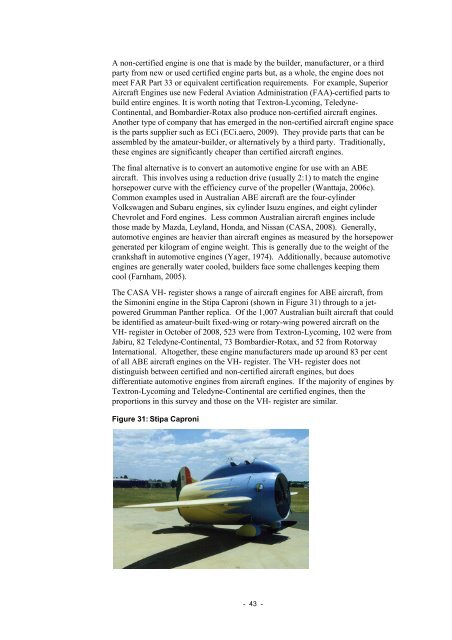Amateur-built and experimental aircraft - Australian Transport Safety ...
Amateur-built and experimental aircraft - Australian Transport Safety ...
Amateur-built and experimental aircraft - Australian Transport Safety ...
Create successful ePaper yourself
Turn your PDF publications into a flip-book with our unique Google optimized e-Paper software.
A non-certified engine is one that is made by the builder, manufacturer, or a third<br />
party from new or used certified engine parts but, as a whole, the engine does not<br />
meet FAR Part 33 or equivalent certification requirements. For example, Superior<br />
Aircraft Engines use new Federal Aviation Administration (FAA)-certified parts to<br />
build entire engines. It is worth noting that Textron-Lycoming, Teledyne-<br />
Continental, <strong>and</strong> Bombardier-Rotax also produce non-certified <strong>aircraft</strong> engines.<br />
Another type of company that has emerged in the non-certified <strong>aircraft</strong> engine space<br />
is the parts supplier such as ECi (ECi.aero, 2009). They provide parts that can be<br />
assembled by the amateur-builder, or alternatively by a third party. Traditionally,<br />
these engines are significantly cheaper than certified <strong>aircraft</strong> engines.<br />
The final alternative is to convert an automotive engine for use with an ABE<br />
<strong>aircraft</strong>. This involves using a reduction drive (usually 2:1) to match the engine<br />
horsepower curve with the efficiency curve of the propeller (Wanttaja, 2006c).<br />
Common examples used in <strong>Australian</strong> ABE <strong>aircraft</strong> are the four-cylinder<br />
Volkswagen <strong>and</strong> Subaru engines, six cylinder Isuzu engines, <strong>and</strong> eight cylinder<br />
Chevrolet <strong>and</strong> Ford engines. Less common <strong>Australian</strong> <strong>aircraft</strong> engines include<br />
those made by Mazda, Leyl<strong>and</strong>, Honda, <strong>and</strong> Nissan (CASA, 2008). Generally,<br />
automotive engines are heavier than <strong>aircraft</strong> engines as measured by the horsepower<br />
generated per kilogram of engine weight. This is generally due to the weight of the<br />
crankshaft in automotive engines (Yager, 1974). Additionally, because automotive<br />
engines are generally water cooled, builders face some challenges keeping them<br />
cool (Farnham, 2005).<br />
The CASA VH- register shows a range of <strong>aircraft</strong> engines for ABE <strong>aircraft</strong>, from<br />
the Simonini engine in the Stipa Caproni (shown in Figure 31) through to a jet-<br />
powered Grumman Panther replica. Of the 1,007 <strong>Australian</strong> <strong>built</strong> <strong>aircraft</strong> that could<br />
be identified as amateur-<strong>built</strong> fixed-wing or rotary-wing powered <strong>aircraft</strong> on the<br />
VH- register in October of 2008, 523 were from Textron-Lycoming, 102 were from<br />
Jabiru, 82 Teledyne-Continental, 73 Bombardier-Rotax, <strong>and</strong> 52 from Rotorway<br />
International. Altogether, these engine manufacturers made up around 83 per cent<br />
of all ABE <strong>aircraft</strong> engines on the VH- register. The VH- register does not<br />
distinguish between certified <strong>and</strong> non-certified <strong>aircraft</strong> engines, but does<br />
differentiate automotive engines from <strong>aircraft</strong> engines. If the majority of engines by<br />
Textron-Lycoming <strong>and</strong> Teledyne-Continental are certified engines, then the<br />
proportions in this survey <strong>and</strong> those on the VH- register are similar.<br />
Figure 31: Stipa Caproni<br />
- 43 -

















